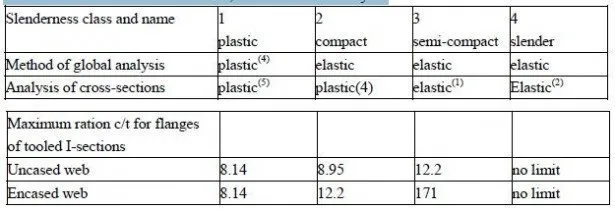For profiled sheeting that relies on frictional interlock to transmit longitudinal shear, there is no satisfactory conceptual model. This led to the development of the shear-bond test, described in Section 2.8.1, and the empirical m-k method of design, where the shear resistance is given by an equation based on (2.33), in the British code or on equation (2.32), in Eurocode 4. With the safety factor added, the Eurocode equation is

where m and k are constants with dimensions of stress, determined from shear-bond tests, and V1, Rd is the design vertical shear resistance for a width of slab b. It is based on the vertical shear at an end support at which longitudinal shear failure occurs in a shear span of length Ls, shown by line 2-2 in Fig.2.19.
For uniformly-distributed load on a span L, the length Ls is taken as L/4. The principle that is used when calculating Ls for other loading is now illustrated by an example.
Calculation of Ls.
The composite slab shown in Fig.3.4(a) has a distributed load w per unit length and a centre point load wL, so the shear force diagram is as shown in Fig.3.4(b). A new shear force diagram is constructed for a span with two point loads only, and the same two end reactions, such that the areas of the positive and negative parts of the diagram equal those of the original diagram. This is shown in Fig.3.4(c), in which each shaded area is 3wL2/8. The positions of the point loads define the lengths of the shear spans. Here, each one is 3L/8.
Defects of the m-k method
The method has proved to be an adequate design tool for profiles with short spans and rather brittle behaviour, that have been widely used in North America. But to exploit fully the ductile behaviour of profile now available, with good mechanical interlock and longer spans, it is necessary to use a partial-interaction method, as explained below.
The defects of the m-k method and of profiles with brittle behaviour are given in papers that set out the new methods, by Bode and Sauerborn in Germany and by Patrick and Bridge in Australia.
They are as follows.
(1) The m-k method is not based on a mechanical model, so that conservative assumption has to be made in design when the dimensions, materials, of loading differ from those used in the tests.
The calculation of Ls, above, is an example of this.
(2) Many additional tests are needed before the range of application can be extended; for example, to include end anchorage or the use of longitudinal reinforcing bars.
(3) The method of evaluation of test data is the same, whether the failure is brittle or ductile. The use in Eurocode 4 of a penalty factor of 0.8 for brittle behaviour does not adequately represent the advantage of using sheeting with good mechanical interlock, because this increases with spans.
Partial-interaction design
The method based on shear-bond tests is described first. The method based on slip-block test, described later, takes more specific account of the effects of traction near supports and can be more economical for short spans.
For composite slabs of given cross-section and materials, the result of each shear-bond test on a profile with ductile behaviour enables the degree of partial shear connection in that test to be calculated. This gives the compressive force Nc transferred from the sheeting to the slab within the shear span of known length Ls. It is assumed that before maximum load is reached, there is complete redistribution of longitudinal shear stress at the interface, so a value for the mean ultimate shear stress Ï„u can be calculated. This is done for a range of shear spans, and the lowest u Ï„ thus found is the basis for a design value, Ï„u Rd . (This is where the greater effect of friction in short spans is neglected.)
At an end support, the bending resistance of the slab is that of the sheeting alone (unless it is enhanced by the use of end anchorage, as described later). At any section at distance x from the
support, the force in the slab can be calculated from u Rd Ï„ , and the method of Section 3.3.1(3) enables the bending resistance M pRd at that section to be calculated. There is usually a midspan region where full shear connection is achieved, and MpRd at the section to be calculated. There is usually a midspan region where full shear connection is achieved, and MpRd is independent of x.
For safe design, this curve of pRd M as a function of x (the resistance diagram) must at all points lie above the bending-moment diagram for the applied loading. If the loading is increased until the curves touch, the position of the point of contact gives the location of the cross-section of flexural failure and, if the interaction is partial, the length of the shear span.
The resistance diagram can easily be modified to take advantage of any end anchorage of slab reinforcement, and the loading diagram can be of any shape.
The method based on data from slip-block tests is similar, except that the resistance is increased near end supports, by an allowance for the effects of friction.
A worked example using data from shear-bond test is given in Section3.4.3.
The only type of end anchorage for which design rules are given in British or European codes is the headed stud, welded through the sheeting to the top flange of a steel beam. The resistance of the anchorage is based on local failure of the sheeting, as explained in commentaries on Eurocode 4; Part 1.1 and BS 5950: Part 3.1.

